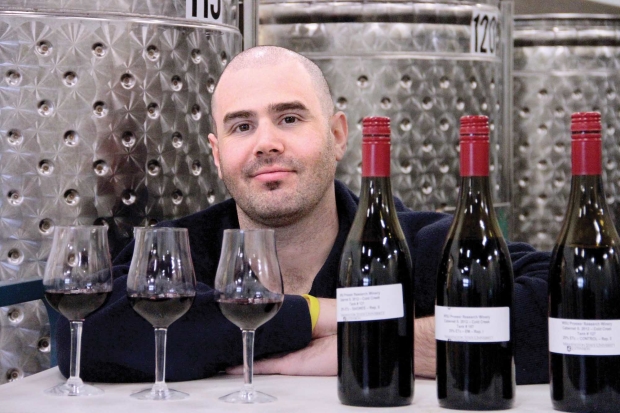
Dr. Luis Federico Casassa (Courtesy Washington State Univeristy)
Regulated deficit irrigation strategies can improve fruit quality by producing smaller berries, but does it affect the chemical and sensory properties of the wine?
Washington State University researchers found that the moderate regulated deficit irrigation strategies generally followed by wine grape growers and more severe deficit irrigation both positively impact the fruity aroma components of red wine. Wines from the more severe irrigation regimes also had the highest color saturation.
Because viticultural practices can impact winemaking and wine quality, wine analysis is an important component of grape research conducted by WSU. Dr. Markus Keller and enologist Dr. James Harbertson recently conducted a regulated deficit irrigation project on Cabernet Sauvignon wine grapes.
Graduate student Dr. Luis Federico Casassa, under the guidance of Harbertson, conducted the wine sensory evaluation portion of the deficit irrigation study. Though Casassa is now at the Wine Research Center of the National Institute of Agronomic Technology in Mendoza, Argentina, he received his PhD in Food Science in 2013.
Wines made from grapes produced under regulated deficit irrigation practices have been chemically evaluated in the past, but little research has been done on the sensory properties of such wines. Casassa shared highlights of his research during the annual meeting of the Washington Association of Wine Grape Growers.
The wine sensory research was conducted from 2008 to 2013 on wines made from grapes from four irrigation regimes: 100 percent evapotranspiration (ET) from fruit set to harvest; 60 to 70 percent ET fruit set to harvest (industry standard); 25 percent ET fruit set to harvest; and 25 percent ET fruit set to veraison, then 100 percent ET veraison to harvest.
Some of the berry and wine chemical differences under the irrigation regimes related to smaller berries from some of the most severe treatments. Small berries have a higher proportion of skin and seed derived compounds, such as anthocyanins, which play a role in wine color, and tannins, which give wines bitterness and astringency.
Casassa found the highest levels of tannins and anthocyanins in the 25 percent ET from fruit set to harvest irrigation regime.
In general, tannins from seeds contributed more to wines than tannins from skins, he said, and noted that tannins from seeds seem to be more difficult to retain in the wine matrix because they may undergo interactions with other components, such as polysaccharides, that can “sequester” them and avoid tannin extraction.
Aromas and color
Casassa was interested in learning if irrigation treatments had an effect on the volatile and aromatic compounds of wine. To measure sensory aspects, Casassa used trained panelists to evaluate the wines for taste, smell, and mouth-feel.
He found an increase in wine anthocyanins, color saturation, bitterness, and astringency ratings in the wines from the 25 percent ET all season compared to other ET regimes, but less consistent effects on aroma. Yields from the 25 percent ET treatment were 30 to 70 percent lower than in the 100 percent ET.
He also observed more color saturation in wines from the industry standard of 70 percent ET and the early deficit (25 percent ET from fruit set to veraison/100 percent ET to harvest). The two treatments also showed a reduced effect on astringency and bitterness.
Both the early deficit (25 ET/100 ET) and industry standard of 70 ET enhanced red and black berry aromas in the wine.
“The results suggest that moderate RDI protocols such as the 70 percent ET and 25/100 percent ET positively impact the fruity component of wine aroma,” he said. “The more severe RDI protocols, like the 25 percent ET all season, increased perceived color saturation, astringency, and bitterness, which could be useful for blending purposes.”
Casassa added that the 25/100 percent ET would be an advisable protocol to follow in Washington State if water supply becomes limited and growers need to manage water more efficiently. •
Casassa’s research was a partnership between WSU and Ste. Michelle Wine Estates, which provided fruit and labor for the experiments.






Hello! This is very interesting. Do you know if their research has been published in a scientific journal?